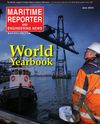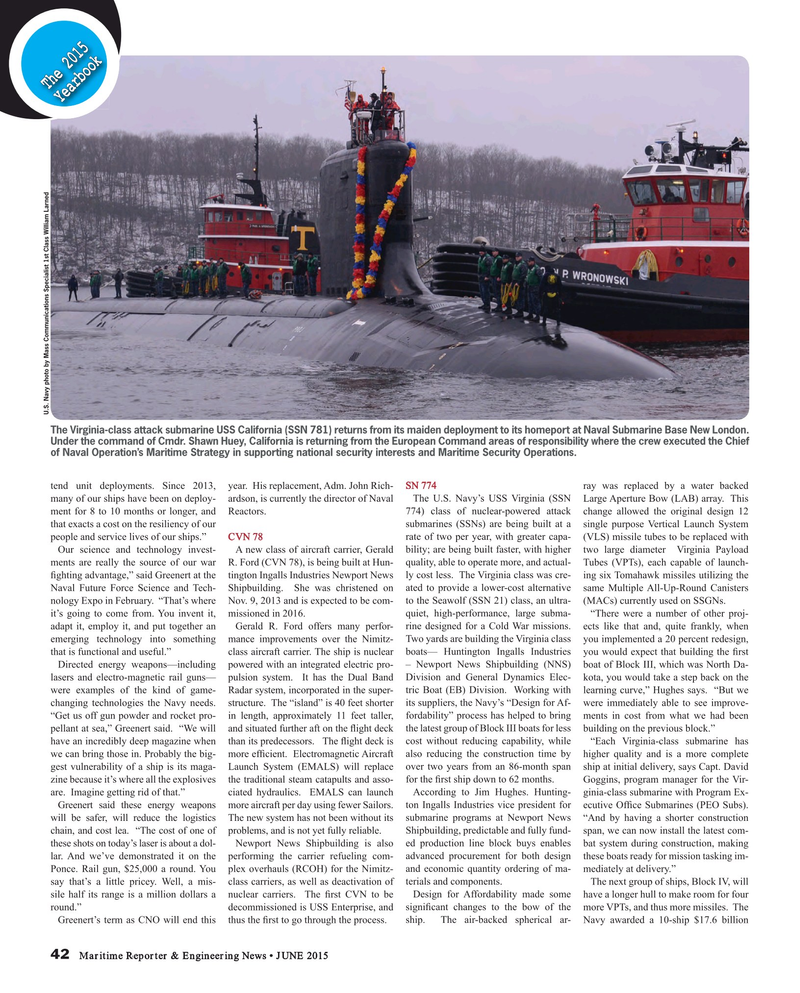
Page 42: of Maritime Reporter Magazine (June 2015)
Annual World Yearbook
Read this page in Pdf, Flash or Html5 edition of June 2015 Maritime Reporter Magazine
The 2015 The 2015
YearbookYearbook
U.S. Navy photo by Mass Communications Specialist 1st Class William Larned
The Virginia-class attack submarine USS California (SSN 781) returns from its maiden deployment to its homeport at Naval Submarine Base New London.
Under the command of Cmdr. Shawn Huey, California is returning from the European Command areas of responsibility where the crew executed the Chief of Naval Operation’s Maritime Strategy in supporting national security interests and Maritime Security Operations. tend unit deployments. Since 2013, year. His replacement, Adm. John Rich- SN 774 ray was replaced by a water backed many of our ships have been on deploy- ardson, is currently the director of Naval The U.S. Navy’s USS Virginia (SSN Large Aperture Bow (LAB) array. This ment for 8 to 10 months or longer, and Reactors. 774) class of nuclear-powered attack change allowed the original design 12 that exacts a cost on the resiliency of our submarines (SSNs) are being built at a single purpose Vertical Launch System people and service lives of our ships.” CVN 78 rate of two per year, with greater capa- (VLS) missile tubes to be replaced with
Our science and technology invest- A new class of aircraft carrier, Gerald bility; are being built faster, with higher two large diameter Virginia Payload ments are really the source of our war R. Ford (CVN 78), is being built at Hun- quality, able to operate more, and actual- Tubes (VPTs), each capable of launch- ? ghting advantage,” said Greenert at the tington Ingalls Industries Newport News ly cost less. The Virginia class was cre- ing six Tomahawk missiles utilizing the
Naval Future Force Science and Tech- Shipbuilding. She was christened on ated to provide a lower-cost alternative same Multiple All-Up-Round Canisters nology Expo in February. “That’s where Nov. 9, 2013 and is expected to be com- to the Seawolf (SSN 21) class, an ultra- (MACs) currently used on SSGNs. it’s going to come from. You invent it, missioned in 2016. quiet, high-performance, large subma- “There were a number of other proj- adapt it, employ it, and put together an Gerald R. Ford offers many perfor- rine designed for a Cold War missions. ects like that and, quite frankly, when emerging technology into something mance improvements over the Nimitz- Two yards are building the Virginia class you implemented a 20 percent redesign, that is functional and useful.” class aircraft carrier. The ship is nuclear boats— Huntington Ingalls Industries you would expect that building the ? rst
Directed energy weapons—including powered with an integrated electric pro- – Newport News Shipbuilding (NNS) boat of Block III, which was North Da- lasers and electro-magnetic rail guns— pulsion system. It has the Dual Band Division and General Dynamics Elec- kota, you would take a step back on the were examples of the kind of game- Radar system, incorporated in the super- tric Boat (EB) Division. Working with learning curve,” Hughes says. “But we changing technologies the Navy needs. structure. The “island” is 40 feet shorter its suppliers, the Navy’s “Design for Af- were immediately able to see improve- “Get us off gun powder and rocket pro- in length, approximately 11 feet taller, fordability” process has helped to bring ments in cost from what we had been pellant at sea,” Greenert said. “We will and situated further aft on the ? ight deck the latest group of Block III boats for less building on the previous block.” have an incredibly deep magazine when than its predecessors. The ? ight deck is cost without reducing capability, while “Each Virginia-class submarine has we can bring those in. Probably the big- more ef? cient. Electromagnetic Aircraft also reducing the construction time by higher quality and is a more complete gest vulnerability of a ship is its maga- Launch System (EMALS) will replace over two years from an 86-month span ship at initial delivery, says Capt. David zine because it’s where all the explosives the traditional steam catapults and asso- for the ? rst ship down to 62 months. Goggins, program manager for the Vir- are. Imagine getting rid of that.” ciated hydraulics. EMALS can launch According to Jim Hughes. Hunting- ginia-class submarine with Program Ex-
Greenert said these energy weapons more aircraft per day using fewer Sailors. ton Ingalls Industries vice president for ecutive Of? ce Submarines (PEO Subs). will be safer, will reduce the logistics The new system has not been without its submarine programs at Newport News “And by having a shorter construction chain, and cost lea. “The cost of one of problems, and is not yet fully reliable. Shipbuilding, predictable and fully fund- span, we can now install the latest com- these shots on today’s laser is about a dol- Newport News Shipbuilding is also ed production line block buys enables bat system during construction, making lar. And we’ve demonstrated it on the performing the carrier refueling com- advanced procurement for both design these boats ready for mission tasking im-
Ponce. Rail gun, $25,000 a round. You plex overhauls (RCOH) for the Nimitz- and economic quantity ordering of ma- mediately at delivery.” say that’s a little pricey. Well, a mis- class carriers, as well as deactivation of terials and components. The next group of ships, Block IV, will sile half its range is a million dollars a nuclear carriers. The ? rst CVN to be Design for Affordability made some have a longer hull to make room for four round.” decommissioned is USS Enterprise, and signi? cant changes to the bow of the more VPTs, and thus more missiles. The
Greenert’s term as CNO will end this thus the ? rst to go through the process. ship. The air-backed spherical ar- Navy awarded a 10-ship $17.6 billion 42 Maritime Reporter & Engineering News • JUNE 2015
MR #6 (42-49).indd 42 MR #6 (42-49).indd 42 6/8/2015 9:51:33 AM6/8/2015 9:51:33 AM

 41
41

 43
43
